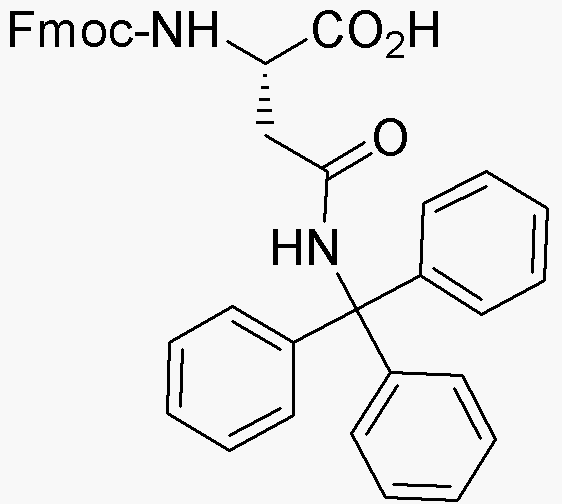Na-Fmoc-Ng-trityl-L-asparagine is widely utilized in research focused on:
- Peptide Synthesis: This compound serves as a key building block in the synthesis of peptides, particularly in solid-phase peptide synthesis, allowing for the creation of complex proteins with specific functionalities.
- Drug Development: It plays a significant role in pharmaceutical research, particularly in the development of peptide-based drugs, which can offer targeted therapeutic effects with fewer side effects compared to traditional small-molecule drugs.
- Bioconjugation: The compound is used in bioconjugation processes, where it helps in attaching biomolecules to surfaces or other molecules, enhancing the efficacy of diagnostics and therapeutics in the biomedical field.
- Research in Neuroscience: Its application in the synthesis of neuropeptides aids researchers in studying neurological pathways and developing treatments for neurodegenerative diseases.
- Protein Engineering: This chemical is instrumental in protein engineering, allowing scientists to modify proteins for improved stability and activity, which is crucial in both industrial applications and therapeutic development.
General Information
Properties
Safety and Regulations
Applications
Na-Fmoc-Ng-trityl-L-asparagine is widely utilized in research focused on:
- Peptide Synthesis: This compound serves as a key building block in the synthesis of peptides, particularly in solid-phase peptide synthesis, allowing for the creation of complex proteins with specific functionalities.
- Drug Development: It plays a significant role in pharmaceutical research, particularly in the development of peptide-based drugs, which can offer targeted therapeutic effects with fewer side effects compared to traditional small-molecule drugs.
- Bioconjugation: The compound is used in bioconjugation processes, where it helps in attaching biomolecules to surfaces or other molecules, enhancing the efficacy of diagnostics and therapeutics in the biomedical field.
- Research in Neuroscience: Its application in the synthesis of neuropeptides aids researchers in studying neurological pathways and developing treatments for neurodegenerative diseases.
- Protein Engineering: This chemical is instrumental in protein engineering, allowing scientists to modify proteins for improved stability and activity, which is crucial in both industrial applications and therapeutic development.
Documents
Safety Data Sheets (SDS)
The SDS provides comprehensive safety information on handling, storage, and disposal of the product.
Product Specification (PS)
The PS provides a comprehensive breakdown of the product’s properties, including chemical composition, physical state, purity, and storage requirements. It also details acceptable quality ranges and the product's intended applications.
Certificates of Analysis (COA)
Search for Certificates of Analysis (COA) by entering the products Lot Number. Lot and Batch Numbers can be found on a product’s label following the words ‘Lot’ or ‘Batch’.
*Catalog Number
*Lot Number
Certificates Of Origin (COO)
This COO confirms the country where the product was manufactured, and also details the materials and components used in it and whether it is derived from natural, synthetic, or other specific sources. This certificate may be required for customs, trade, and regulatory compliance.
*Catalog Number
*Lot Number
Safety Data Sheets (SDS)
The SDS provides comprehensive safety information on handling, storage, and disposal of the product.
DownloadProduct Specification (PS)
The PS provides a comprehensive breakdown of the product’s properties, including chemical composition, physical state, purity, and storage requirements. It also details acceptable quality ranges and the product's intended applications.
DownloadCertificates of Analysis (COA)
Search for Certificates of Analysis (COA) by entering the products Lot Number. Lot and Batch Numbers can be found on a product’s label following the words ‘Lot’ or ‘Batch’.
*Catalog Number
*Lot Number
Certificates Of Origin (COO)
This COO confirms the country where the product was manufactured, and also details the materials and components used in it and whether it is derived from natural, synthetic, or other specific sources. This certificate may be required for customs, trade, and regulatory compliance.


